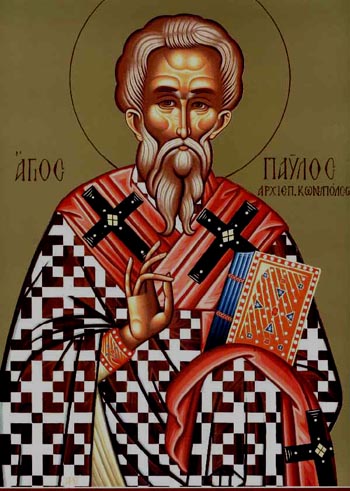
Saint Paul was born in Thessaloniki, Greece in the start of the fourth century. Both of his parents were Christians and he was raised close to the faith. He was inspired by Saint Dimitrios and read his life many times. He remained pure in his youth, and was highly educated.
The Archbishop at this time was Mitrophanis and his was of great age; 117 years old. This was also during the time of the first ecumenical council. Because Archbishop Mirtophanis could not attend as he was bedridden, he send Paul and another named Alexander in his place. Paul was a reader and helped explain different arguments.
When Alexander and Paul returned, successful in defeating the Arians heresies, Mirtophanis rejoiced. God then revealed to the dying Archbishop a prophecy. He saw that Alexander was to take his place and then following Paul would take Alexander’s place. When Metrophanis died shortly after, the prophecy came true and Alexnader was ordained Archbishop. He then made Paul a priest to assist him with his new duties.
For his first job, he worked as the secretary of the Holy Archbishop of Constantinople, Alexander. He would humbly do the paperwork needed and was a pious man and always remained calmed when solving matters.
In the year 340 on August 30th, Alexander passed and Paul was chosen to replace him as the Archbishop of Constantinople. It was also at this time that the Arian heresies had manifested once more.
Many Arians were a part of the council and they were greatly opposed to Paul replacing Alexander, but through God’s grace, the majority of the council was Orthodox and Paul took his place.
At this time, 340 AD, the emperor Constantius was Arian as well. He controlled the eastern district of the Roman empire. At the time the council was held, Constantius was not present and when he returned he was outraged to discover a new bishop had been appointed.
He then gathered the council once more, and against the tradition practice, he had Paul exiled and revoked his title as Patriarch. The emperor instead chose Eusebius of Nicodemia, who was an unrighteous man as well as a great heretic to the church.
Paul, now banished from Constantinople, retreated to Rome where other bishops were exiled due to the new election of Eusebius.
Eusebius remained Patriarch for the rest of his life, but he passed shortly after he was appointed. Paul was then welcomed back with open arms to Constantinople, as many of the Christians had a great love for him. When he returned, the Macedonians were in control of the church and they were great Arian heretics at this time.
When Constantius discovered his return, he banished him for a second time and Paul resided once more in Rome. There Paul found the Saint Athanasius the Great who was Patriarch of Alexandria at the time as he was also exiled due to Constantius. They spoke of the situation and the Western emperor, Constans got word of what Constantius was doing.
The Western emperor was a just man, and although harsh with his words, his intentions were well. He wrote a letter to Constantius ridiculing him for his mistreatment of Paul. Constantius did not wish to grow tensions between Rome and Constantinople, so he permitted Paul to come back to the city where he was again made Archbishop. Athanasius was also properly returned to Alexandria as Archbishop. For the next three years, Constantinople was brought glory and peace.
It was not long after that Constans was murdered brutally during a palace coup, and this gave Constantius the free range to once more banish Paul from Constantinople, which he chose to do. Rather than going to Rome, they had sent him to Cucusus Armenia.
He was mistreated by the Armenians and during the procession of the Divine Liturgy, they came into the church and attacked him mercilessly. Strangling him with his omophorion, he gave his soul unto the Lord through martyrdom in the year 355 AD, only 15 years after he was appointed Archbishop for the first time.
31 years later, his holy relics were transferred by the pious emperor Theodosius the Great and remained in Constantinople. They were first in the church of Saint Eirini, and then moved to a church built in Saint Paul’s honor. His whole body remained in Constantinople until 1326 when they were moved to a monastery in Venice. There were other holy relics at this monastery including Saint Saint Barbaros the Myrrhgusher, Saint Lorenzos, and Saint Candida. Saint Paul’s head is at Simon Peter Monastery in Mount Athos.
Those chanting psalms can pray to Saint Paul the Confessor for help and he will come to their aid. Those suffering from pain in the neck can also pray to Saint Paul and he will heal you.